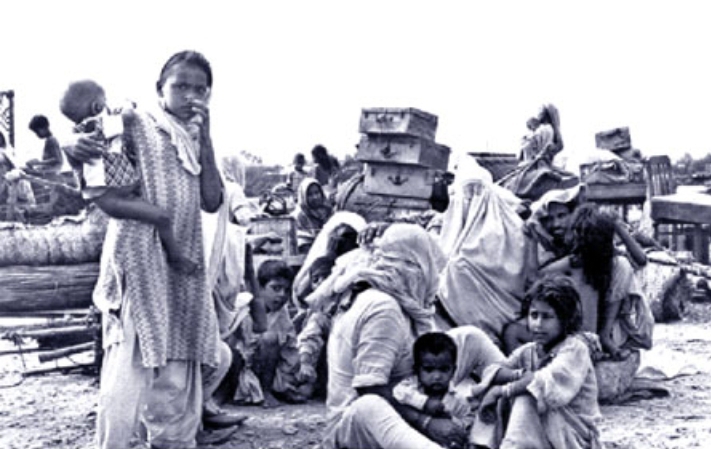
Narratives of displacement, disorientation and trauma in Sindh makes us revisit the horror of Partition. There is a need to delve deep into the Sindh story, the Sindhi predicament and formulate a solution.
Prof Ravi Prakash Tekchandani and Dr. Neelam Mittal
Belonging… “May not be a physical space but a sense we carry in our bodies and pass down generations.” It goes deeper than the name of a place or “a stamp on the passport. It’s as deep as the soil of the earth”. (Aanchal Malhotra)
The Independence of India, coterminous with the Partition of the country and mass exodus of the people from their homes and hearth led to a pattern of violence and retaliation, anger and apathy for suffering of the ‘other’ and a sinking down to the bestial abyss. Partition of the country has been a black day in the history of India.
Result of Divide and Rule Policy
The atrocities of the Partition embodied the success of the British ‘Divide and Rule’ policy. While Punjab was divided into East and West Punjab, likewise, Bengal got partitioned into East and West Bengal. However the whole of Sindh province was left to Pakistan. Sindhi people, Sindhi language, art, literature, culture as well as Sindhi identity were de-territoriolized. Identity is connected with roots; the soil beneath our feet. Deprived of this soil, this marker of identity, Sindhi people were disoriented and orphaned. There was bitterness, discontent, and heart-wrenching pain; of course, the natural outcome of the heartache and heartbreak caused by a sudden forfeiture and deprivation of material possessions and cultural, linguistic and psychological markers of human identity. The following poem registers the plight of Sindhis displaced and disoriented from their motherland:
Karte ho yaad Azadi ko yaar saal dar saal,
’47 ki kaali raat bhi yaad karke to dekho!
Khoon, balaatkaar, Vichho khud ba khud
nazar aa jayenge,
Kisi Sindhi ki aankh me zara jhaank ke to dekho!
(Ravi Prakash Tekchandani, Vibhajan Ke Khandar)
The need of the contemporary world is to inculcate the capacity to transcend one’s reductive, insular, centripetal consciousness and the willingness to develop a centrifugal consciousness and an ability to understand the loss incurred by the people of Sindh.
Identity Crisis for Bharat
Sindh is an innate part and defining factor of the identity of Bharat. It is unfortunate that the foundation stone laid by the Indus Valley Civilization is not present on the map of Bharat. The loss of Sindh province, the excruciating pain of Sindhis at the human level, the splintered cartography and physical and psychological dissection of the country encapsulates an identity crisis for Bharat. Hence, Partition implies not just territorial severance and geographical loss; it brings Sindhi language, culture, literature, and society and Sindhi identity in a challenging parenthesis. Land and language are inextricably linked. The language crisis is evinced in the Sindhi youth, now alienated from the territory of Sindh, Sindhi vocabulary, and Sindhi terminology. The literary crisis arises from the fact that being deterritorialised, Sindhi literature has become literature of a scattered people; it is disjointed and dissociated from Sindhi land, culture, local food and local people. Sindhi culture has also adopted the flavor of their adopted arena, losing touch with pan- Sindhi culture, cuisine, art, painting, embroidery, sartorial manner, and Sindhi way of living.
The sublime efforts of honorable Prime Minister of India, Narendra Modi, to celebrate the 75th year of Independence as Azadi ka Amrit Mahotsav throughout the country are complemented by sincere efforts to pay homage to Partition Horror Remembrance Day, as a sincere memorial for the intense loss suffered by a nondescript and displaced people.
Hence, there is an incumbent need to delve deep into the Sindh story (katha), the Sindhi predicament (vyatha), and formulate a solution for the same (samadhan). The suggested solution can be an appeal to the Ministry of Home Affairs to preserve and conserve Sindhi identity. Since, Gujarati language Kachchh is the language of the Sindhi people and since Kachchh district of Gujarat is the biggest district of India, it can be converted into the Union Territory of India, ‘Sindh and Kachchh Province’ to give a sense of identity and space to Sindhi people to preserve and promote their language, literature and culture and reinstitute Sindhi identity.
______________________
Courtesy: Organizer (Published on Aug 14, 2022)